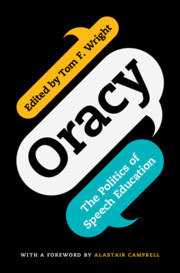Book contents
- Oracy
- Oracy
- Copyright page
- Contents
- Figures
- Tables
- Contributors
- Foreword: The Oracy That Democracy Needs
- Acknowledgements
- Introduction
- Part I Debating Oracy in the UK
- Part II Oracy in Global Context
- Part III Oracy in History and in Theory
- 10 What the Chartists and Suffragettes Realised about Oracy
- 11 From Elocution to Empowerment
- 12 Releasing Civic Voices
- 13 The Trouble with Oracy?
- Index
- References
10 - What the Chartists and Suffragettes Realised about Oracy
from Part III - Oracy in History and in Theory
Published online by Cambridge University Press: 23 September 2025
- Oracy
- Oracy
- Copyright page
- Contents
- Figures
- Tables
- Contributors
- Foreword: The Oracy That Democracy Needs
- Acknowledgements
- Introduction
- Part I Debating Oracy in the UK
- Part II Oracy in Global Context
- Part III Oracy in History and in Theory
- 10 What the Chartists and Suffragettes Realised about Oracy
- 11 From Elocution to Empowerment
- 12 Releasing Civic Voices
- 13 The Trouble with Oracy?
- Index
- References
Summary
In this chapter, evidence from past social movements highlights oracy education’s role in empowering marginalized communities in 19th-century Britain. Critics argue that oracy education diverts attention from socio-economic issues, exerting coercive control over the powerless. However, grassroots oracy within movements like Chartism and Suffragettes challenges these notions. The struggle for articulacy, I show, underpinned the struggle for the vote. These examples underscore grassroots oracy’s historical significance and potential implications for contemporary policy debates.
Information
- Type
- Chapter
- Information
- OracyThe Politics of Speech Education, pp. 129 - 151Publisher: Cambridge University PressPrint publication year: 2025
References
Accessibility standard: WCAG 2.2 AAA
Why this information is here
This section outlines the accessibility features of this content - including support for screen readers, full keyboard navigation and high-contrast display options. This may not be relevant for you.Accessibility Information
Content Navigation
Allows you to navigate directly to chapters, sections, or non‐text items through a linked table of contents, reducing the need for extensive scrolling.
Provides an interactive index, letting you go straight to where a term or subject appears in the text without manual searching.
Reading Order & Textual Equivalents
You will encounter all content (including footnotes, captions, etc.) in a clear, sequential flow, making it easier to follow with assistive tools like screen readers.
You get concise descriptions (for images, charts, or media clips), ensuring you do not miss crucial information when visual or audio elements are not accessible.
You get more than just short alt text: you have comprehensive text equivalents, transcripts, captions, or audio descriptions for substantial non‐text content, which is especially helpful for complex visuals or multimedia.
Visual Accessibility
You will still understand key ideas or prompts without relying solely on colour, which is especially helpful if you have colour vision deficiencies.
You benefit from high‐contrast text, which improves legibility if you have low vision or if you are reading in less‐than‐ideal lighting conditions.
